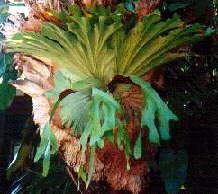Staghorn Fern

Staghorn Fern: Platycerium superbum Additional Information: 'Staghorn Fern' Platycerium superbum There is usually one large salad looking base leaf. The photosynthetic fronds tend to start thin, then widen into a 'hand' split into many fingers.
Platycerium spp. This is a group of about 15 species (Warren 1999) found in rainforests throughout the tropics, where they grow on trees. They develop with two sets of leaves; the first set are sterile and hold in debris to support the plant, while the other leaves are photosynthetic and release the spore. All species in this genus look similar, with the green leaves growing out and splitting, thus looking like the antlers that develop on male deer, and giving them the common names. Some, like some African species, do not split much at all, while others, split a lot. They can hang down from their host trees quite a distance. Some species are commonly called 'Elkhorns' although there doesn't seem to be any consistency in naming, and therefore there is no biological distinction or significance between the names 'staghorn' and 'elkhorn'. And in fact, in the case of two Australian species they have actually been named opposite to what they should be! That is, the so called 'elkhorn fern' has bifurcating leaves more like a regular deer stag, while the common staghorn fern has a larger base and 'fingers' much more like an elk antler. Thus it is probably best just to call them all 'staghorn ferns'.
Script: Courtesy of Damon Ramsey BSc.(Zool) Biologist Guide Additional Staghorn Fern Photos |
